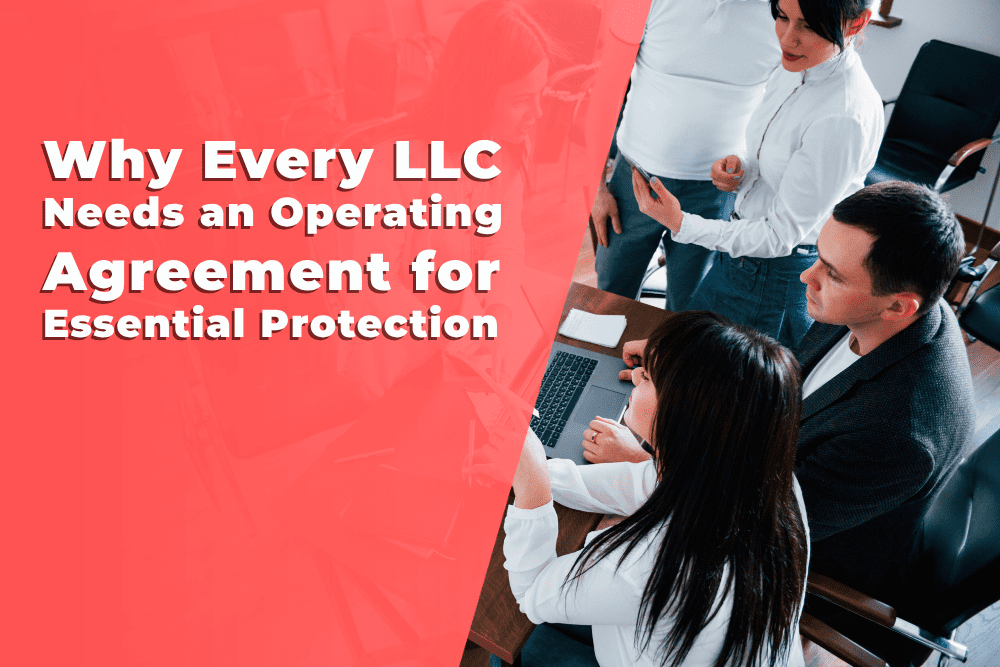Starting an LLC (Limited Liability Company) is an exciting step for any entrepreneur. It’s flexible, provides personal asset protection, and works well for small businesses. However, a crucial step that many new LLC owners overlook is creating an LLC Operating Agreement. This essential document outlines how the LLC will operate, who owns it, and the rules all members agree to follow. In simple terms, an LLC Operating Agreement acts as a rulebook, protecting both your business and personal assets.
1. What Is an LLC Operating Agreement?
An LLC Operating Agreement is a legal document that defines the organization’s structure, operations, and ownership. It’s the agreement that members (owners) of the LLC sign to spell out each person’s roles and responsibilities, profit-sharing rules, and procedures for handling disputes or significant business decisions. While some states don’t require LLCs to have an operating agreement, it’s still an important document that every LLC should have, as it offers legal protections and clarity in operations.
2. Why Is an LLC Operating Agreement Important?
A. Legal Protection
Without an LLC Operating Agreement, the LLC could be subject to default rules established by the state, which might not reflect the owners’ intentions or protect their interests. An operating agreement solidifies the limited liability status, helping to protect members’ personal assets from the company’s debts and liabilities. This document is also critical in legal disputes, as it shows the court that the LLC members followed their internal rules.
B. Clear Ownership and Profit Distribution
An LLC Operating Agreement specifies the ownership percentage each member has, ensuring everyone knows their stake in the business. It also outlines how profits and losses will be shared, helping avoid confusion or conflicts later.
C. Establishes Roles and Responsibilities
One of the key functions of an LLC Operating Agreement is to clarify who is responsible for which tasks within the company. This can help avoid disagreements over who should handle specific duties or decisions. By detailing roles and responsibilities, an operating agreement allows members to focus on their unique contributions without overlap or confusion.
D. Decision-Making Process
An LLC Operating Agreement should include a section on how decisions are made within the company. For example, it could require a majority vote for significant decisions, like taking on debt or buying property. Having this in writing provides clarity on decision-making authority, especially if disagreements arise.
E. Handling Changes in Membership
LLCs may face situations where a member leaves, retires, or wants to sell their share. Without an LLC Operating Agreement, there may be no clear process for handling these situations. The agreement provides guidelines for transferring ownership or managing a buyout, ensuring stability and continuity for the business.
3. Key Components of an LLC Operating Agreement
Ownership and Membership Structure
The first part of an LLC Operating Agreement should define who owns the LLC and what percentage each member holds. This is important not only for clarity but also for legal purposes, as it provides a clear record of ownership from the beginning.
Voting Rights and Decision-Making
An LLC Operating Agreement should specify the voting rights of each member, especially if the members have different levels of ownership. This section should also outline the decision-making process, including whether decisions require a unanimous vote, a simple majority, or another type of approval.
Distribution of Profits and Losses
The agreement should specify how profits and losses are divided among the members. For example, will they be distributed equally, or will it depend on each member’s investment in the LLC? Clear guidelines on profit distribution prevent misunderstandings down the road.
Management Structure: Member-Managed or Manager-Managed?
In an LLC, members can manage the company directly (member-managed) or hire one or more managers to handle day-to-day operations (manager-managed). The LLC Operating Agreement should clarify which management structure the business will use, as this affects everyone’s roles and responsibilities.
Procedures for Adding or Removing Members
Adding or removing members can be a complex process, especially if the LLC is already operating. The operating agreement should provide instructions on how members can join or leave the company, including the financial implications of such changes.
Dissolution and Winding Up
If the LLC ever needs to be dissolved, the operating agreement should outline the steps for closing the business. This might include selling assets, settling debts, and distributing remaining funds to the members.
4. How an LLC Operating Agreement Protects Your Business
Safeguarding Limited Liability Status
One of the most important reasons for an LLC Operating Agreement is to protect the limited liability status of the LLC. Without this agreement, an LLC could be seen as a sole proprietorship or partnership, making members personally liable for the company’s debts.
Preventing Member Disputes
An operating agreement acts as a reference for resolving disputes, as it provides guidelines agreed upon by all members from the start. In case of disagreement, the document serves as a neutral reference, which can help defuse conflicts before they escalate.
Avoiding State-Imposed Default Rules
If you don’t have an LLC Operating Agreement, your state’s laws will dictate how the LLC should operate. State-imposed rules may not align with your business’s unique needs, making it vital to have an agreement that customizes the LLC’s operations according to your specific requirements.
You may also like to read:
The Ultimate Guide to Starting a Business: LLC vs. Corporation
Starting a business is a dream for many entrepreneurs, but choosing the right structure can be challenging. Two popular options, LLC vs. Corporation, each …
Read More

5. Creating an LLC Operating Agreement: Steps to Get Started
Step 1: Decide on Your Management Structure
Determine whether your LLC will be member-managed or manager-managed. This decision affects how you draft the responsibilities and roles in the operating agreement.
Step 2: Define Ownership and Voting Rights
Clearly outline each member’s ownership percentage and voting power. This helps prevent misunderstandings down the line and establishes a fair decision-making process.
Step 3: Outline Profit Distribution
Specify how profits (and losses) will be distributed among members. Even if all members agree to equal distribution initially, it’s important to document this decision.
Step 4: Draft Guidelines for Adding or Removing Members
Plan for the future by creating clear guidelines for what happens if someone wants to join or leave the LLC. Include details on the buy-in or buyout process, so everyone knows what to expect.
Step 5: Plan for Dissolution
While it may feel strange to plan for ending the business, having a dissolution process in place is essential. Your operating agreement should outline how remaining assets will be distributed and how debts will be settled.
6. Common Mistakes to Avoid in an LLC Operating Agreement
Leaving It Too Vague
An effective LLC Operating Agreement is specific, covering everything from decision-making to profit distribution. Avoid leaving important terms open to interpretation, as this can lead to disputes and legal issues.
Not Updating the Agreement
As your business grows, it’s essential to keep your LLC Operating Agreement up to date. Amend it to reflect changes in ownership, management, or company policies.
Not Having All Members Sign the Agreement
Ensure all LLC members sign the operating agreement to make it legally binding. Without signatures, the document may not hold up in court.
7. Do Single-Member LLCs Need an Operating Agreement?
Yes, even if you’re the only member, it’s recommended to have an LLC Operating Agreement. This document reinforces the limited liability status of your LLC, separating your personal assets from business liabilities. It can also help establish credibility with banks and potential investors.
8. When to Update Your LLC Operating Agreement
An LLC Operating Agreement isn’t a one-time document. It’s wise to review and update it as your business grows and evolves. For example, consider updating it when:
- A new member joins or an existing one leaves.
- You want to change the profit-sharing structure.
- Major changes in the company’s direction or ownership occur.
By making regular updates, you’ll ensure that your agreement always reflects the current needs of your LLC.



